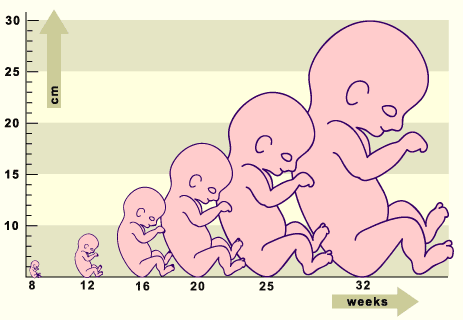|

|
|
|
9.2 The form and position of the child in utero
|
|
|
Development of the external form of the embryo
|
|
|
|
More info
|
|
Kartagener's syndrome is a typical developmental picture characterized by a situs inversus (transposition of the viscera), immotile cilia in the bronchial tree, infertility and abnormities in the sinus cavity. The fundamental cause is a mutation that leads to immotility of cilia and spermatozoa.
|
|
|
|
|
Fig. 4 - Embryo in stage 14
view from the right |
|
Legend |

1
2
3
4
5
6
7
8
9
|
Upper extremities
Heart primordium
Somites or derivates
Lower extremities
Maxillary primordium (pharyngeal arch I)
Optic cup
Telencephalon
Umbilical cord
Caudal eminence |
|
|
|
Fig. 4
The embryo is 33 days old and 5 - 7 mm long. Well visible are the forming eyes, the limb buds and the heart primordium. In this stage, the embryo has attained its greatest flexion.
|
Development of the form and position of the fetus
|
|
|
|
In the fetal period large changes of the form no longer take place. It is a period of growth. With the increase in size, especially of the inner organs, and with the overall growth of the fetus it stretches itself out again and takes on its typical shape.
Normally, it positions itself so it is aligned with the longitudinal axis of the mother and, 96 % of the time, with its head downwards (head presentation). Probably, the pear-shaped form of the uterus is responsible for this, in that the head fits better into the narrower lower part than the lower extremities do.
|
|
|
| Fig. 5 - Growth of the fetus during the fetal period |
|
Legend |

|
|
Fig. 5
The comparison of the fetal crown-rump length shows the enormous increase in size during the fetal period.
The fetal crown-
rump length at 8 weeks amounts to just 3 cm while that of the fetus at birth comes to over 30 cm (highly schematic drawing).
|
|
More info
|
|
It is important for the obstetrician to know which part of the fetus presents itself first at birth. Interestingly, in the great majority (96%) of all deliveries, it is the head that presents first and, within this portion, the anterior vertex or occipital presentation of the child. This means that in the course of the delivery, the occiput leads initially and the child turns itself with its back towards the front / towards the pubic symphysis.
|
|
|
|
|
|
|

